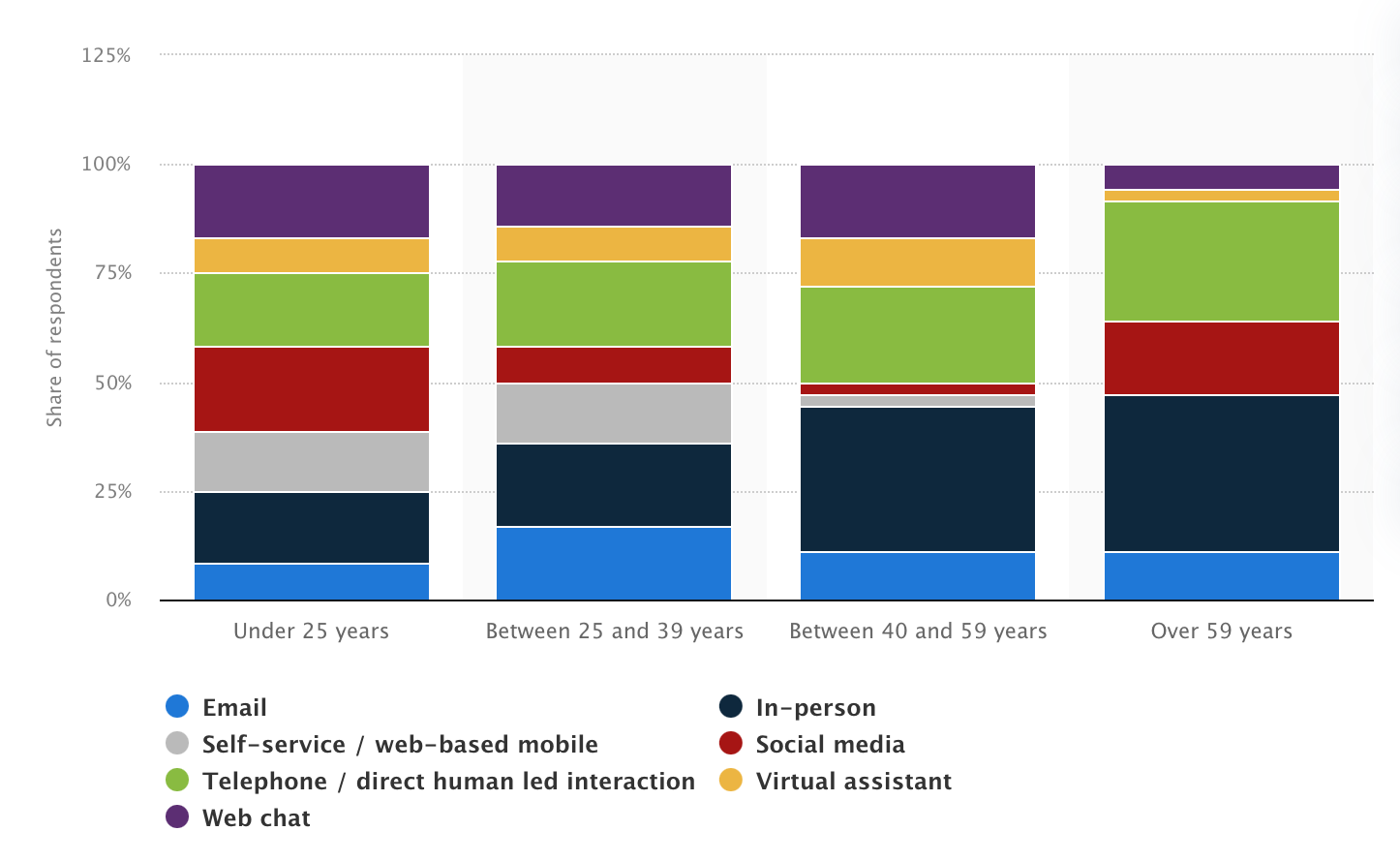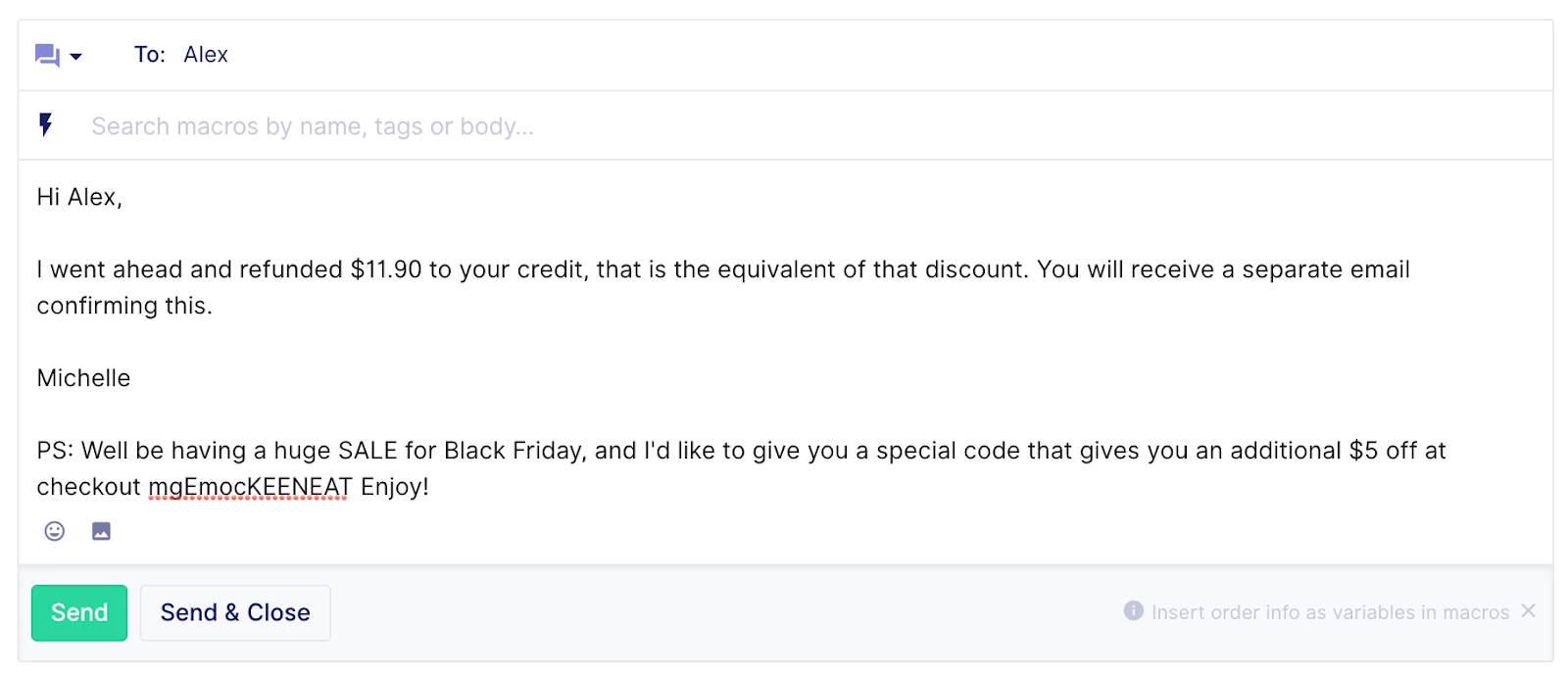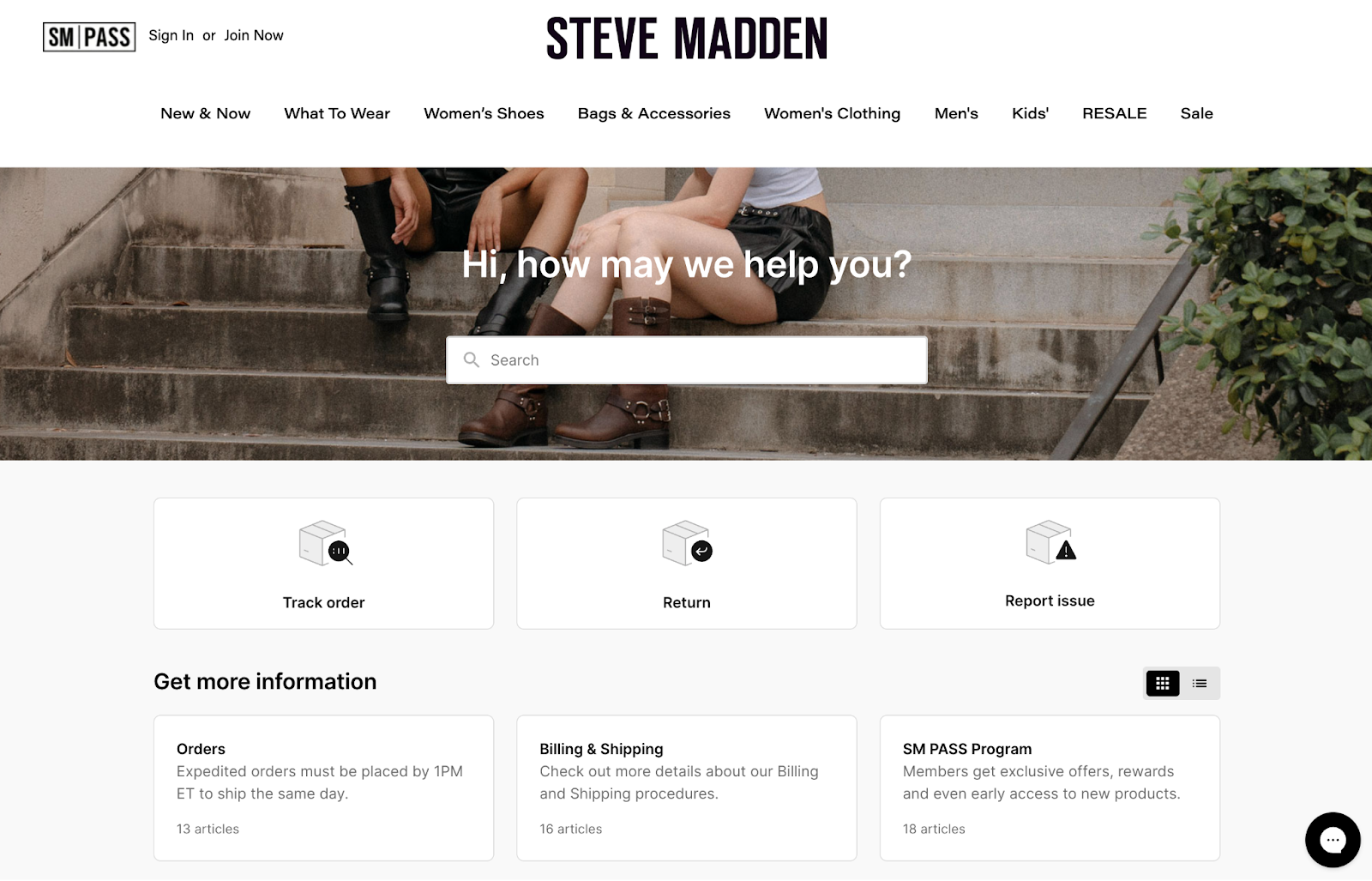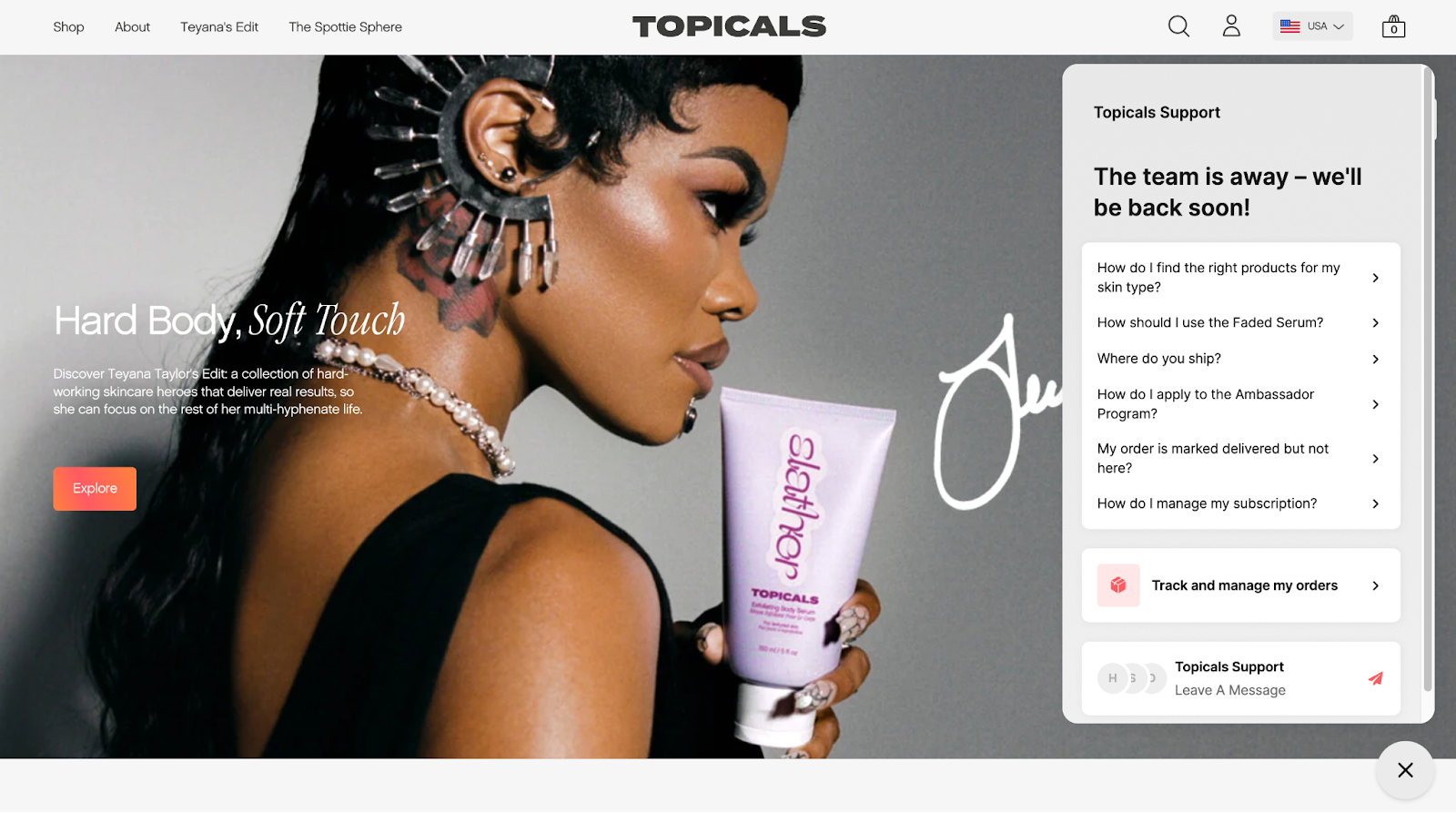Holidays are around the corner. You’ve stocked up on inventory, launched your campaigns, and have your sales funnel locked down. But have you planned for the unavoidable holiday rush of customer service requests?
Starting the Black Friday Cyber Monday weekend and through the end of the year, the pressure and expectations from your support team reach their peak.
If you want to be the ecommerce brand your customers remember this holiday season (and come back to when January rolls around), while also running a balanced, healthy customer support operation, you’re in the right place. This guide shares 10 actionable tips to help prepare for the busy holiday customer service season.
Table of contents
- Prepare for the holiday rush
- Schedule ecommerce customer support
- Set up critical holiday communication channels
- Use customer support to enable sales
- Field common requests with bots and self-service options
- Open internal communication
- Staff and outsource for extra demand
- Win with customer service beyond the holidays
- Support your customer support
- Get the support you need
1. Prepare for the holiday rush
First things first: Accept that holidays will definitely bring your customer service team a busy season. And then, take dedicated steps to prepare for the rush.
Here’s what Lauren Donnelly, the former director of CX at Boll & Branch, suggests:
- Optimize your support contact forms: Gather as much relevant information as early in the conversation as possible.
- Run product training sessions: Consider video training, up-to-date documentation, and day-long training to equip your in-house team. Don’t forget to prep any outsourced, third-party support.
- Consider automation: Your customer support tool may have options like triggers and auto-tagging, which will lower the manual, admin part of your agents’ workload.
- Forecast demand for support: Review your daily and year-over-year support ticket trends, as well as hourly requests per channel, so you can determine the right coverage for each channel and period.
Ecommerce brands see a 79% average spike in support tickets in the first week of December—right after Black Friday Cyber Monday promotions. Afterward, the number of tickets per week stays above average during December (minus the week following Christmas), as well as in early January, before it goes back to usual.
Because of this, no start is too early. “We start drafting pre-season and December messaging well in advance. This includes all social media posts, emails, and ad campaigns,” says Steve Pogson, founder of First Pier, an ecommerce agency and a Shopify partner. “The goal is not to wait for the last minute but to have everything ready and scheduled. This approach ensures that our team can focus on real-time customer service issues, not scrambling to get communications out.”
This is also a good time to establish metrics you’ll use to track the success of your customer support team. Some metrics to consider include:
- Customer satisfaction score (CSAT): the indicator of customer satisfaction on a scale from zero to 100%.
- Customer effort score (CES): the average score of answers to the prompt “[Company] made it easy for me to solve the issue” on a scale of either five or seven points.
- First response time (FRT): the average time between a customer reaching out and an agent first responding to it.
This way, you can compare these metrics between holidays and the rest of the year, and notice any peaks and drops so you can react quickly.
2. Schedule ecommerce customer support
Consider tweaking your customer support schedule over the holidays to maximize each agent’s time and impact.
This might not be necessary when the cadence of support requests is lower, but a clear schedule makes it a lot easier for agents to solve customer issues once the number of tickets jumps.
At Magnolia, a home and lifestyle brand, the typical customer support schedule includes agents that work on one live channel during the day, like phone or live chat, and rotate around halfway point during the day. The brand also has one or two people on backup in case of a traffic spike.
But it’s a different story during holidays. “We schedule each agent for certain time frames, so each agent works on their allotted time frame of email tickets, and once they are done with that section of their tickets, they get a new assignment of tickets to knock out,” explains Sam Goff, former guest services manager at Magnolia.
“Our backup agents usually jump straight to phone and voicemails versus emails,” he adds. The team at Magnolia praises this approach for bringing down the number of tickets quickly.
If you cover a wide range of products or serve a global audience, consider routing support tickets to agents based on their product-specific skill set or a language they speak. Not only will this help them solve requests fast—the personal touch will feel extra delightful to the customer.
3. Set up critical holiday communication channels
You might be tempted to nail every single support channel, but this hectic period might stretch your customer service team so thin that they’ll struggle with all of them.
A better option? Define your critical customer support channels for the holidays, then double down on them.
Take it from Campus Protein. Its team recognizes that customers are being bombarded by deals and have a higher than usual purchase intent. Answering their questions quickly is crucial.
“Traditional channels such as email are just not fast enough. We use chat, text, and phone support to help minimize our response time, and maximize the customer’s overall experience,” says Tarun Singh, Campus Protein’s chief marketing officer and co-founder.
The support channels you choose should depend entirely on the audience you serve. For example, social media is often the go-to customer support channel for people under 25, but one of the least preferred options for the 40 to 59 age group, according to Statista.

Preferred customer contact channels for different age groups.
This is why knowing your audience can pay off. It’s how you’ll prevent spending your time and budget on customer support technology for channels your customers don’t even use.
Boll & Branch, a luxury bedding brand, directs its focus on phone and chat. “Our customer demographic isn’t looking for self-serve support options, so they’ll reach out to speak with a person to verify their question or concern,” explains Lauren Donnelly, former director of CX at Boll & Branch.
Transparency is key. Fast Friends Fungi, the brand of functional mushrooms, proactively shares its holiday hours, response times, and shipping times on key channels, including social media, emails, and a website pop-up as the holidays approach.
“We aim to reply within 24 to 48 hours on weekdays. We may reply sooner, but we prefer to give ourselves some buffer. We don’t believe our team needs to be available 24/7, and we aren’t! Our company values being disconnected for our own mental sanity,” says Hilary Johnson, founder of Fast Friends Fungi.
4. Use customer support to enable sales
One of the best things about holiday customer support is that it isn’t—and shouldn’t be—siloed away from sales. In fact, it’s a core part of it. Some three in four consumers will spend more with businesses that provide a good customer experience, and companies that focus on customer experience are 60% more profitable.
What are some ways you can make that happen with your holiday support?
Just like sales associates in a physical store, your customer support agents should be fully equipped to answer product-specific questions and help the customer make their purchase decision.
Romain Lapeyre, CEO at ecommerce customer service software Gorgias, says this effort is more than worth it: “We’ve found that repeat purchases can be up to four times higher for customers who contacted support and had a positive experience. As an example, if 10% of your customers contact support and have a great experience, you can increase your repeat purchase rate by 30%.”
Another quick win he recommends is embedding your marketing efforts into support messages during the holiday season. “Support emails have a nearly 100% open rate—you should take advantage of that,” he adds.

Sample customer service email with a line that enables holiday sales.
5. Field common requests with bots and self-service options
Many of your customer queries fall under the category of common requests. These include questions like:
- “How long until my order is here?”
- “How can I return my order?”
- “Where should I enter the promo code?”
- “Can I change the delivery address for my order?”
- “Do you ship to [country]?”
These are quite easy to answer, and generally don’t take your agents long to solve. The problem arises when these common requests take up so much of your support team’s time that they don’t have the capacity to deal with more complex customer issues.
The solution? One option is a knowledge base that answers frequently asked questions. It needs to be easy to find and navigate, and always up-to-date, just like the one on the Steve Madden online store.

Knowledge base on Steve Madden’s website.
Another approach you can take is a bot that’s always visible at the corner of your website. Upon clicking it, visitors should see commonly asked questions and an option to ask follow-up questions or other questions they haven’t found the answer to themselves.
There are many ways to implement this—here’s how Topicals, a skin care brand, makes it work.

Topicals’ self-service support option.
“When setting this up, let the customer know that the message they’re receiving is an automated response. While sending automated responses means that your customers are getting instant answers to their questions, it shouldn’t mean that your support team considers these conversations as closed,” suggests Romain Lapeyre, Gorgias’ CEO. “Your team should take a look to ensure that the bot responded properly, and answer any follow-up questions if needed.”
Not only does this technology make it easier to manage customer requests, shoppers who plan to spend more money are more likely to use technology while shopping. According to recent data collected in the Shopify–Gallup Holiday Shopping Pulse surveys, shoppers who plan to spend more than $1,200 this BFCM are at least twice as likely to use chatbots and virtual assistants (as well as technology like spatial commerce and VR).
6. Open internal communication
Customer support agents aren’t the only ones under extra stress during the peak shopping season. More orders mean more workload for everyone—marketing, design, product development, inventory management, and engineering.
So how can you ensure smooth internal communication with all that extra workload?
The best way to go is to integrate your customer support solution with a tool you use to communicate internally. This way, you can send all the context the other person needs to assist you or jump into the conversation with the customer. No repeating yourself and no loss of information on the way.
This approach works best when it’s also connected to your customer information—previous purchases, loyalty program status, and past customer service interactions. That way, every team can focus on their jobs instead of looking for the right customer detail.
7. Staff and outsource for extra demand
Should you consider outsourcing your customer support team to help with potential holiday overflow?
If there’s any chance your current team won’t be able to handle the ticket volume, the answer is yes. By the time the busy season rolls around, it might be too late to get the additional agents up to speed, so make a decision as early as you can. Use last year’s holiday peak to estimate the volume you can expect this year and run with that.
“You need enough seasonal help to respond to every customer in a timely manner, but the breakdown of channels where these inquiries are coming from is also crucial,” says Amanda Schermerhorn, former operations manager at Darn Good Yarn, an organic women’s clothing brand.
“For example, we learned that a majority of our questions were coming through either live chat or phone calls, which tells us our customers want an immediate response instead of leaving a message.” Darn Good Yarn used that data to hire and train for all of their live support queries over the holiday period.
At Boll & Branch, the team used to assign its outsourced customer support agents to phone calls, but it reconsidered its strategy. “We found that from a productivity and quality standpoint, it’s more beneficial for the outsourced team to clear the easy wins. This way, our internal teams who have the most access to updated product info can spend their time on inquiries that are harder to solve,” says Lauren Donnelly, former associate director of CX at Boll & Branch.
8. Win with customer service beyond the holidays
The best thing about holiday customer support is that you can make it a differentiator for your brand all year round.
Some customers will interact with you for the first time during this season, but when their delight is embedded into your company culture, many will want to buy from you all the time, not just when the holiday promotions roll around.
Take it from Bombas, a comfort-focused sock and apparel brand. Bombas is known for its 100% Happiness Guarantee, the policy that promises to replace or refund items if they’re torn, the wrong size, and even lost in the laundry or disappeared with lost luggage.

Bombas’ Happiness Guarantee page.
The brand empowers its team to live up to the ideals of this policy so they never have to wait for an approval to go above and beyond for a customer.
“The Happiness Guarantee is nothing without smart, passionate people making it real. Our hiring process is rigorous. We look for people who understand that, fundamentally, we’re treating every interaction as an opportunity to bring people closer to our brand,” says Drew Stadler, former VP of customer happiness at Bombas.
This is a brand differentiator, and Bombas has the numbers to prove it: Customers who reach out to the happiness team have twice the customer lifetime value (LTV) compared to those who don’t.
Russell Saks, the CEO of supplement brands Campus Protein and BEAM, encourages the support team to be more proactive than usual during the holidays. “We model this off of the shopping experience in your favorite retail store, where assistance comes to you instead of the other way around. This experience is what helps our customers feel confident about their purchase and that they arrived at the right website this holiday season,” he adds.
9. Support your customer support
The holidays are busy and exciting. But for online businesses and their support teams, they’re also stressful, with risks of frustration, exhaustion, and burnout.
That’s why making your support reps cared for and supported is essential.
One approach you can model is the one from Bombas. Drew Stadler, its former VP of customer happiness, lists some ways the company looks after its employees to make sure holidays don’t take a mental and physical toll on them:
- Ensuring there’s sufficient staff so that everyone can take enough time off and stay healthy and rested.
- Offering catered meals and snacks, team collaboration, and fun surprises to keep morale up.
- Running weekly dedicated one-on-one meetings with the direct manager so each rep can share feedback and touch base on how they’re feeling.

Celebrations in the Bombas office.
At Magnolia, managers and supervisors run two daily touchpoint meetings. The morning one is for vision and preparation for the day, while the afternoon meeting is for recapping the day and reading positive feedback that came in for the team. “It’s crucial for us to focus on the positive feedback during holidays, because it’s so easy to get wrapped up in the hustle and bustle of the season,” says Sam Goff, former guest services manager at Magnolia.
Just like Bombas, folks at Magnolia ensure there are plenty of built-in breaks and team activities, as well as food, games, and Christmas music, so everyone can relax and have fun with each other.
10. Get the support you need
Finally: What do you need to feel supported, equipped, and ready for this holiday season?
What kind of customer support does your ecommerce platform offer? Are there risks of downtime due to high website traffic or transactions? Will it be challenging to manage a larger order and ticket volume in the back end of your online store?
Take the time right now to find answers to these questions. Also, check if your plan includes priority support, the channels you can use to get support, and the average waiting time.
For example, Shopify Plus offers 24/7 priority support to merchants, a 99.99% uptime, and help with third-party integrations or finding approved Shopify Plus Partners. In other words, Shopify Plus takes care of you so you can take care of your customers.
Get your customer support ready for this holiday season
A customer’s experience with your support team holds a lot of power. Do it wrong, and it’s the last interaction they have with you. Get it right, and you can turn this customer into a fan that keeps buying from you for years and sends other people your way.
That’s true all year round, but during holidays, getting it right is tougher.
It’s why you shouldn’t skip holiday prep for your support team. Set up your key support channels, communicate your support schedule to customers, lean on AI and self-service options to field common questions, and outsource some of your support if your current team’s capacity won’t be enough.
Put your customers first this holiday season, and you’ll reap the rewards for months and years to come.
Holiday customer service FAQ
How do you attract customers on holidays?
Run holiday marketing campaigns like gift bundles, custom discounts, limited-edition products, and gift-buying guides. Make the shopping experience smooth through transparent payment, shipping, and return options, and make customer support easy to reach.
How do you define great customer service?
The foundation of great customer service is knowing the needs of your target customers well, and using that knowledge to meet their expectations. Ensure easy, seamless interactions that solve customer issues quickly and with empathy—that’s what makes great customer service all year round.
Why is customer support important in ecommerce?
When you prioritize customer support in your ecommerce store, you generate more customer loyalty and trust, encourage repeat purchases, grow your brand awareness, and create the foundation for long-term growth.
Read More
- 14 Video Ads That Blew Our Minds In 2015
- Top Omnichannel Logistics and Supply Chain Challenges in Ecommerce
- How You Can Profit from Personalizing Content on Your Ecommerce Store
- Stop Trying to Increase Your Conversion Rates
- Multichannel Inventory Management: Problems & Solutions
- Consumer Psychology: Sell to the Person Behind the Persona
- What Is Stock Management? The Complete Guide to Managing Your Ecommerce Products
- The Dirty Little Secret Traditional Enterprise Software Companies Don't Want You Knowing
- The 1 Rule for Building a Billion-Dollar Business
- Fast Customer Service: An Easy Way to Improve Your Retail Business






